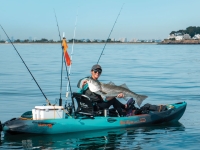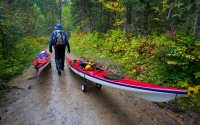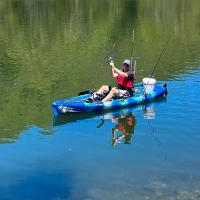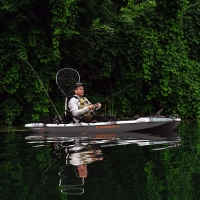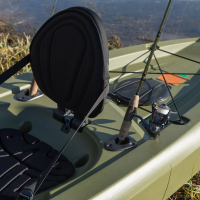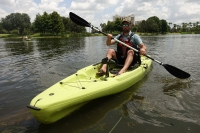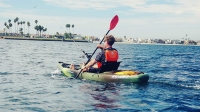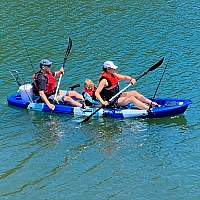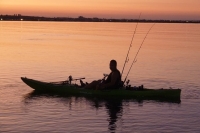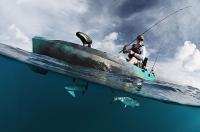Understanding the Design and Structure of a Sit on Top Fishing Kayak
The sit on top fishing kayak is akin to the Swiss army knife of the angling world - each design element serves a purpose and contributes to your ultimate fishing experience. At first glance, you'll notice the open design, a departure from traditional kayaks. This feature is not a design accident, but a deliberate strategy to ease your entry and exit. The fear of being trapped in an enclosed cockpit during a rollover is nonexistent here. Instead, you have an open platform that lets you slide in and out at your will, like a seal slipping off a rock into the sea.
Another critical element is the self-bailing system. Picture this - you're on the water, hooked into a feisty largemouth bass, when a wave washes over your kayak. Instead of finding yourself in a puddle, the strategically placed scupper holes in the bottom of the sit on top kayak allow the water to drain out. The kayak virtually bails itself out, leaving you dry and focused on your prize catch.
Lastly, let's talk about the hull design. The hull is often overlooked but plays a crucial role in performance. Most sit on top fishing kayaks employ a tri-form hull design. This includes a central pontoon for tracking (keeping straight) and two outer pontoons for stability. It's the equivalent of having built-in training wheels, keeping you balanced even as you wrestle with your catch.
Exploring the Stability and Balance Offered by a Sit on Top Fishing Kayak
When you're out on the water, perched on your sit on top fishing kayak, the last thing you want to worry about is capsizing. Stability, in this context, is the kayak's ability to stay upright under the angler's movements. Fortunately, the sit on top fishing kayak scores high on this front. A lot of this is down to its broad, flat-bottomed design, and low center of gravity. When you're casting your line or turning around to grab a piece of gear, this design keeps the kayak stable and less likely to tip over.
Let's dive a bit deeper into kayak stability. There are two types you'll want to know about: primary and secondary. Primary stability, or initial stability, describes how the kayak feels when you're sitting still in calm water. Secondary stability, on the other hand, refers to how the kayak behaves when you're moving, say, while changing direction or when you're in choppy waters. Sit on top fishing kayaks are known for their excellent primary stability, but don't discount their secondary stability either. This makes them a fantastic choice for beginners who are still getting their sea legs, as well as seasoned anglers who crave that extra assurance while wrangling a big fish.
The Convenience of Storage and Access in a Sit on Top Fishing Kayak
One of the main advantages of a sit on top fishing kayak is the ample storage space it offers. Ever tried searching for your tackle box or spare lures in a cluttered, cramped space? It's no fun. The sit on top fishing kayak circumvents this issue with aplomb. Many models come with hatches, both bow and stern, that offer waterproof storage space. Ideal for stowing away your valuables, extra clothes, and lunch. The open deck layout also means you can strap larger items, like a cooler or a tackle bag, directly to the kayak's surface.
But it doesn't stop at storage. Built-in rod holders, accessory tracks for adding gadgets, adjustable footrests for comfort, cup holders for hydration – the sit on top kayak has it all. A big one is the gear tracks system, a set of rails that allow you to attach, move, and detach accessories without drilling into your kayak. Want to add a camera to capture your catches? No problem. What about a fish finder to locate your scaly prey? Easy-peasy. These features make sit on top fishing kayaks the very embodiment of convenience and functionality. With everything within arm's reach, you can spend less time fumbling for gear and more time on what you came for - fishing.
Advantages of Sit on Top Fishing Kayaks for Different Water Conditions
Sit on top fishing kayaks are like chameleons – they can adapt and excel in a multitude of water environments. Take, for instance, the calm and serene setting of a placid lake. Here, the broad, flat-bottomed design of the sit on top kayak ensures stability, allowing you to cast and reel without fear of toppling. But what if you're in a fast-flowing river, where currents can be tricky and water conditions change rapidly? The sit on top kayak rises to the challenge with its robust hull design, offering excellent tracking to keep you on course.
Venturing into the open sea or the choppy waters of a large lake? The sit on top kayak can handle that too. Thanks to its excellent secondary stability and self-draining ability, you can weather the waves without having a mini-flood on deck. It's worth mentioning that sit on top kayaks have an inherent safety advantage in these conditions. If a wave flips you over, the open design allows for easy re-entry from the water, unlike a traditional kayak.
How a Sit on Top Fishing Kayak Enhances Mobility and Ease of Use
If there's a quality that elevates the sit on top fishing kayak from its peers, it's the sheer ease of use. The open, user-friendly design practically invites you to slide in and get paddling. Even if you're a beginner, the learning curve is more of a gentle slope. You don't need to master the art of entering a small cockpit while keeping the kayak stable, or worry about the claustrophobic feeling of being enclosed in a traditional kayak.
Mobility is another shining attribute of the sit on top fishing kayak. You are not confined to a small space. Instead, you have the liberty to move around, stretch your legs, or even stand up while fishing. It's as close as you can get to the freedom of bank fishing while still enjoying the advantages of being on the water. Plus, the 360-degree access means you can cast in any direction, taking full advantage of every ripple and splash that hints at a fish lurking beneath the water's surface.
The Durability and Longevity of Sit on Top Fishing Kayaks
If you're investing time and money into a hobby, you want to ensure it lasts. And when it comes to durability, sit on top fishing kayaks really hold their own. Most are made from high-density polyethylene – a tough, lightweight material that can withstand the typical bumps and knocks that come with life on the water. It's also highly resistant to UV radiation, meaning your kayak won't degrade and weaken under the relentless sun.
But it's not just about the material – the construction process also plays a part in durability. Many sit on top kayaks are rotomolded – a manufacturing process where the polyethylene is heated and rotated to form a uniform, one-piece shell. This means no seams that can come apart over time. If cared for properly, these sturdy crafts will provide you with many seasons of fishing fun. Just like a loyal hound, a sit on top fishing kayak is a companion that sticks with you through thick and thin.
Comparison of Sit on Top Fishing Kayak Versus Traditional Kayak Models
When it comes to the debate between sit on top fishing kayaks and their traditional counterparts, it's like comparing apples and oranges. Both have their merits, but the former tends to be a more suitable choice for anglers. The advantages are manifold. The open design, for starters, not only provides easy access but also eliminates the feeling of confinement some people experience in traditional kayaks. Plus, the self-bailing system means no more bailing water out with a sponge or a pump.
What about storage? Traditional kayaks usually come with a closed hatch or two for storing gear, but their space is often limited and can be difficult to access while on the water. Sit on top fishing kayaks, on the other hand, often have more generous and accessible storage options. They come equipped with molded-in storage wells, cup holders, and gear tracks for attaching everything from rod holders to GPS units.
Customization Possibilities with a Sit on Top Fishing Kayak
The world of kayak fishing is as varied as the fish in the sea, and a sit on top fishing kayak is the perfect canvas for expressing your angling style. With a wealth of customization options at your disposal, you can deck out your kayak to suit your specific needs. For instance, you might decide to add a swivel rod holder that allows you to troll as you paddle. Or maybe you'd like to install a GPS system to help navigate large bodies of water.
The possibilities don't stop there. Many sit on top fishing kayaks come with accessory tracks or mounting points, enabling you to attach anything from additional rod holders to camera mounts. You could even add a trolling motor if you'd like to cover more water without tiring yourself out. With a sit on top fishing kayak, the power to customize is firmly in your hands.
Tips for Maintaining and Cleaning Your Sit on Top Fishing Kayak
Like any piece of outdoor gear, a sit on top fishing kayak requires a bit of TLC to keep it in top shape. Regular cleaning is the first step. A simple rinse with fresh water after each use can go a long way in preventing salt, dirt, and grime from building up. For a more thorough cleaning, use mild soap and a soft brush to gently scrub the kayak, paying special attention to the footwells and storage areas.
Transport and storage also play a significant role in maintaining your kayak. Avoid dragging your kayak over rough surfaces, which can cause unnecessary wear and tear. When storing, keep your kayak in a cool, shaded area to protect it from prolonged sun exposure. A kayak cover can provide additional protection from the elements.
Learning to Fish from a Sit on Top Fishing Kayak: Beginners’ Tips and Techniques
Taking up kayak fishing is a thrilling endeavor. And while there is a learning curve, a sit on top fishing kayak makes it easier to get started. Begin by mastering the basics of paddling – the forward stroke, reverse stroke, and sweep stroke. These will help you maneuver the kayak with ease. Next, get comfortable casting and reeling from a seated position. It may feel a bit different from what you're used to on the shore, but with a bit of practice, you'll get the hang of it.
Fishing from a kayak also means you'll need to learn some new skills, like anchoring and drift fishing. These techniques will allow you to maintain your position or control your movement so you can focus on fishing. Don't forget about safety either. Always wear a personal flotation device (PFD), and take along a whistle or other signaling device in case of emergencies. With these tips in mind, you'll be well on your way to mastering the art of sit on top kayak fishing.




